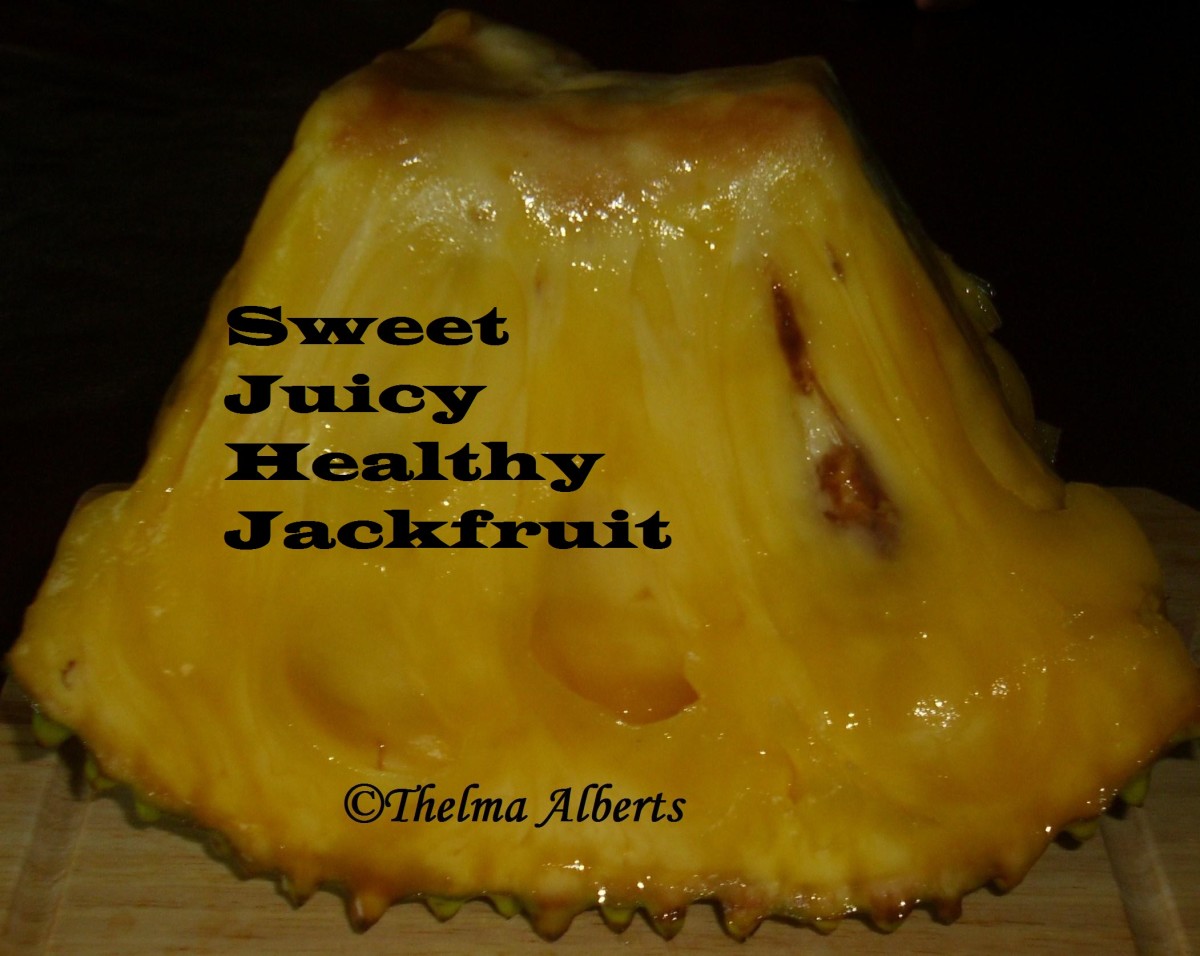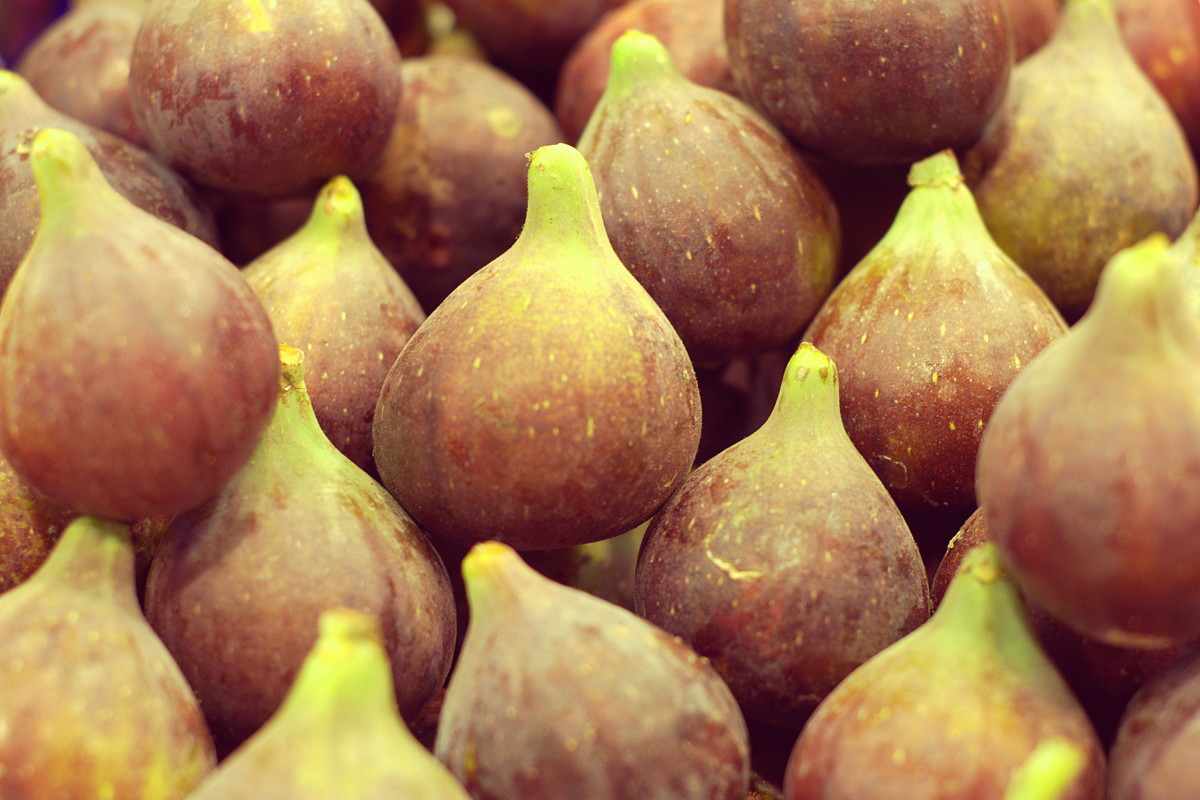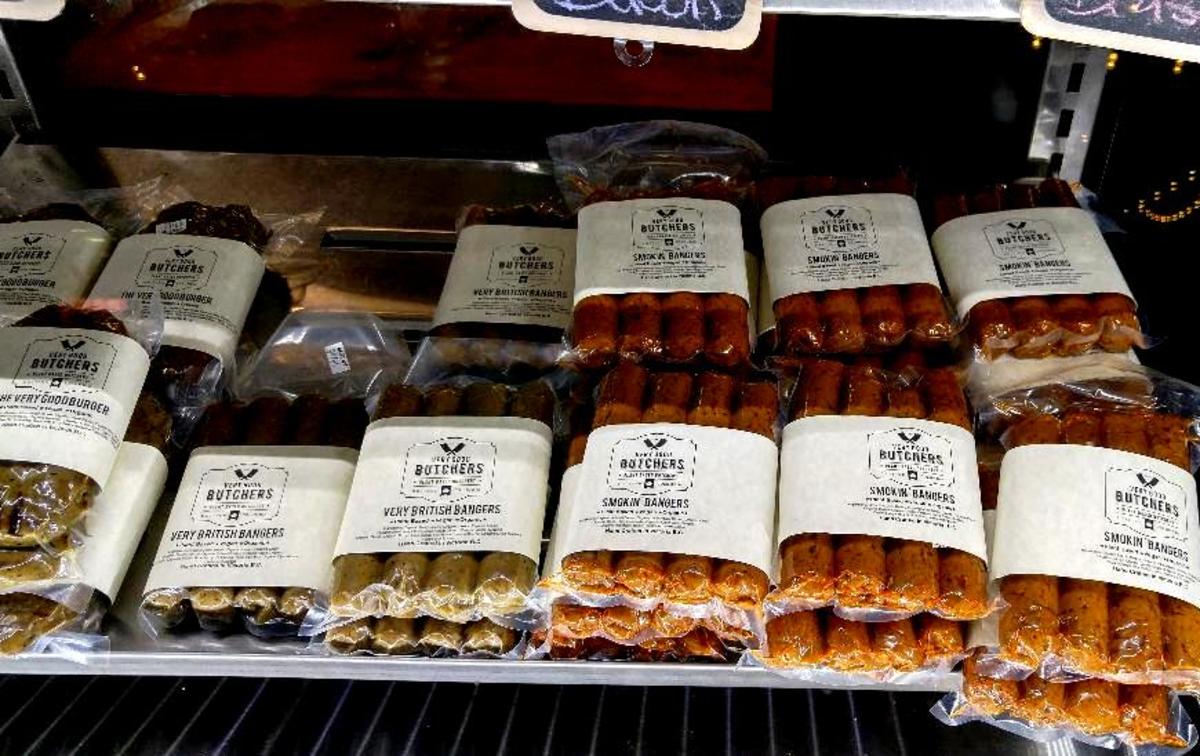Fresh Figs: When Are Figs Ripe?
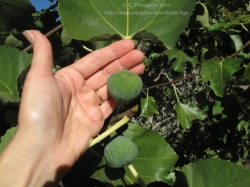
What Does a Ripe Fig Look Like?
When are figs ripe? When do you pick figs?
When is fig season? Don't look at the calendar, look at the figs! The right time to pick fresh figs varies from season to season and in different locations. You need to know the signs to tell if figs are ripe. The LOOK AND FEEL of ripe figs is what tells you if they are ripe.
Read on for a stepwise guide to ripe figs. You will see what color a ripe fig is and how a ripe fig feels to your touch as they mature, so you can tell when to pick them. You will also get updates about the current fig season different places. For example, our figs are starting be to ripe now in N. California.
All images © E. Friedman 2011, all rights reserved, except as noted for other photographer.
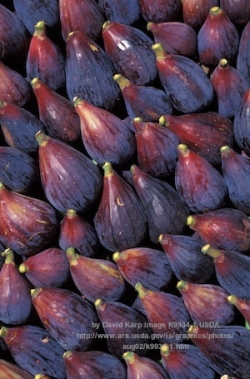
Black Mission Figs are Dark When Ripe
It's easier to tell when black figs are ripe than with greener figs we grow. The ripe black figs shown in this photo are Mission Figs. Their dark color is very different from the Iight color of ripe Kadota figs shown in my photographs throughout most of this page.
There is a huge black mission fig tree in the lot next to our house.
Image credit: David Karp, courtesy of USDA http://www.ars.usda.gov/is/graphics/photos/aug02/k...
When Are Southern Hemisphere Figs Ripe?
Wondering when to pick Southern Hemisphere figs? Southern hemisphere figs in areas such as Australia are just beginning their season when the last of figs are being picked in the north.
In Australia, some varieties produce two crops a year. Look to pick ripe figs in Australia around December and again in February.
But remember, the LOOK AND FEEL of the figs tells you if figs are ripe. So read on. The Step-Wise Guide to When Figs are Ripe works where ever you are.
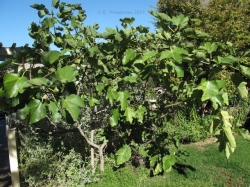
Stepwise Guide to When Figs are Ripe
Kadota figs and some other varieties are greenish in color even when ripe. The step-wise guide shown here as you scroll down should help you decide when your figs are ripe especially if you have one of these varieties.
Our fig trees were here when we moved in, so we are unsure of the variety. Unlike mission figs, the figs on our kadota trees are greenish to cream color when ripe. In California, some common types of figs are black mission figs, calimyrna figs and kadota figs. The fruit of mission figs turns a dark purplish color when ripe, not like ours. The fruit of our trees ends up a pale creamy green color. Based on shape and taste, ours most likely are kadota figs. Another possibility are Adriatic figs or maybe a hybrid of these varieties, but they are most likely kadota.
Fig trees get quite large, and fig leaves are enormous. Fig trees need a lot of sunshine, and they will "steal it" from the rest of the garden.
The following Stepwise Guide to When Figs are Ripe is divided into 3 parts:
* Unripe Figs
*Ripening Figs
*Ripe Fig Ready to Pick
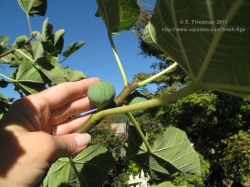
Unripe Figs: Small, Green and Upright
Figs that are very green and stand up from the stem are unripe. They are relatively small and fairly firm to the touch, but avoid too much touching because it can bruise them. Also, some people have a skin reaction to unripe figs, as described below.
The sap of unripe figs can be especially irritating. If you were to pick the figs at this stage, the sap would run very white and milky.
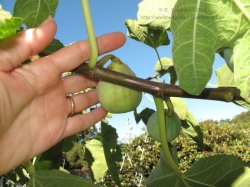
Ripe Figs: Larger, Paler Green and Droop
The kadota fig shown here is not fully ripe, but it is close to mature. Notice that the fig is larger and droops on its stem. The droop is a big hint to ripeness. This fig is still slightly too green and too firm to be fully ripe, but it could be picked and eaten at this stage.
Kadota figs especially near the coast are slightly green even when ripe - essentially a green ripe fig.
You may wonder, "Do figs ripen after being picked?" Sadly, it is not really possible to ripen figs on the kitchen table as you might do with other fruits. Figs do not ripen well after being picked and should be kept in the refrigerator until eating.
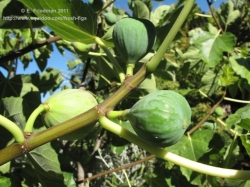
When To Pick?
The fig season
The fig season varies by species, location and year based on differences in temperature, humidity, sunshine and rainfall. For example the fig season in Southern California is earlier than in Northern California; the season for Mission figs generally starts earlier than for Kadota (the early Mission fig crop comes in late May through June)
A general rule is Mission figs in North America start late May to June (1st crop) and possibly late July but likely Aug to September (2nd crop). Kadota (greenish figs) have a crop by late July and mostly August to end September. It's best to learn the signs of a ripening fig for your own tree and just keep checking.
Here are details of the three stages to decide when to pick your figs.
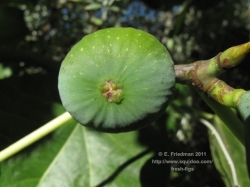
Stage 1: The Unripe Fig
Unripe figs are deep green, firm, small and they stand up from the stem. Another hint to ripeness is shown in the detail here. The end of the fruit away from the stem is tightly closed. Don't pick it now. It won't ripen off the tree.
This fig is not yet open for business!
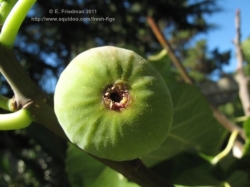
Stage 2: The Ripening Fig
Now you begin to see changes. After what seems like an age, especially in a cool or rainy summer, the fig finally has soaked in the sun to ripen. It begins to go fairly quickly, so you can see daily changes in the fruit. The ripening fig gets larger. It begins to plump out. The color changes, getting less green and more creamy or yellowish in color for this variety (remember, some varieties such as Mission Figs will turn a dark purplish color as they ripen.) It gives slightly to the touch (or bruises, so be careful not to over-test.) And as you have learned here, the fruit begins to droop.
The detail of ripening you can notice up close: the end away from the stem begins to open a little portal. The fig may even begin to ooze a tiny droplet of nectar from this opening.
Now comes the hard choice: Should you pick it? If the end is truly opened, it is likely ripe enough to eat, but it may not be fully ripe and have attained the peak of its rich, ripe flavor. So what is the hint that tells you it's truly ripe? Read on to Stage 3.
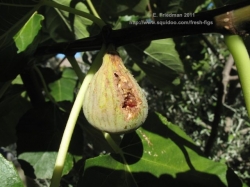
Stage 3: The Fully Ripe Fig
You can tell a fig is truly ripe and delicious when you find it half-eaten by a bird or squirrel.
About 10 minutes after any fig gets ripe, a bird pecks it or a squirrel grabs it - at least it seems that way. For the best fig taste, you need to leave the fig on the tree until truly ripe. They do not continue to ripen after picked and in fact they spoil fairly soon. If you keep a picked fig overnight, put it in the fridge.
In this picture of our tree: Notice how the bird has thoughtfully revealed the inner flesh of the fig fruit so that you can see what a fully ripe fig looks like inside.
Last summer we tried hanging aluminum foils strips to the tree. You could almost hear the mockingbird laughing. Or should I say mocking.
Next we tried hanging a few old CDs to twist in the breeze. AOL seems to work best. :-) But the effect wore off after a couple of weeks.
The best solution is just hope you get enough figs to share with the birds and still have some for yourself.
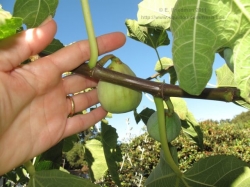
What Color Are Ripe Figs?
To help decide when are figs ripe, you may ask, "What color are ripe figs?" Answer: Very light greenish OR very dark purple color.
For unripe figs - color is predictable. Unripe figs are small and green. But the color of a fig when ripe varies, depending on which variety. Notice the greenish-creamy Iight color of the almost ripe figs shown in this photo. These ripe-green-figs are possibly Kadota figs or maybe Adriatic figs shown in my photographs through this page.
I had been familiar with figs that are dark purplish color when ripe, such as the ripe Mission figs from the California Central Valley shown here. So I kept waiting for our green figs at the house where we now live to turn dark - but they don't. Being a different variety, likely Kadota , they only turn a light creamy greenish yellow color.
How do you tell what color your own figs are when ripe? If you are unsure of which variety you have, you can look for a change in color as a hint of ripeness. Also look for the typical droop on stem, opening of the end of the fruit and slight softness of the fig as indicators of whether or not a fig is ripe. Once you do a few trial and error tests this way, you will know what color a ripe fig is for your own particular tree.

What to Do With Ripe Figs
Wondering what to do with ripe figs?
Chef Elizabeth at Elizabeth's Kitchen in San Diego has this suggestion for what to do with fresh figs:
Fresh Fig Recipe
"I like figs wrapped in prosciutto, and stuffed with blue cheese, baked and served on top of a inkie puddle of a good balsamic, like a vanilla fig balsamic blend."
Visit her website for more free recipes, cooking news and music. Yes, music. This chef also sings opera.
CLICK HERE----> Elizabeth's Kitchen
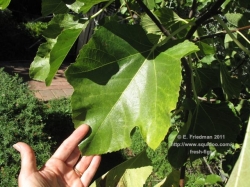
Fig Leaves Are Big
No wonder they feature in ancient stories as a way to cover the body. Fig leaves are huge. However, they may not make great clothing as some people have a contact reaction to them, although it is mainly to the sap.
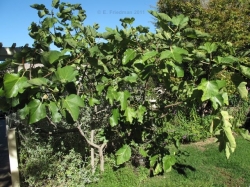
Which Species Do You Have?
It's not always easy to know which species or variety of fig you have unless you purchased the tree from a grower yourself. There are 720 known varieties of fig grown as food around the world. Here's a guide as a start:
Edible figs are generally the common fig with scientific name Ficus carica.
Commercial figs: Smyrna or Calimyrna in California, require pollination to set fruit. This is done by a small wasp. The source of pollen is from caprifigs that make male and female flowers. The edible Calimyrna has only femaie flowers, and that is where the female wasp must crawl inside to carry in pollen. Growers must have caprifigs and wasps available to get fruit from their Smyrna or Calimyrna tree.
Garden figs: These can be from a number of varieties or hybrids that do not require pollination to set fruit. Kadota makes a sweet, small to medium greenish white fruit. An Adriatic fig such as Verone makes a slightly larger top-shaped greenish-yellow fruit.
Information based on this excellent USDA article by David Himelrick 1999 that you can read for FREE when you CLICK HERE ---> Fig Production Guide
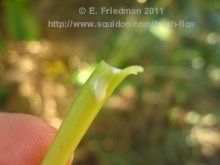
Caution: Sensitivity to Fig Sap
Some people report a sensitivity to fig sap. The reactions to fig sap may show up as a skin rash or for some people, a soreness of the lips and gums after eating (lots of) fresh figs. In rare cases, people have a more serious and different type of reaction to fig sap, an anaphylactic shock, but that is entirely different.
The reaction to figs I mention is generally mild and usually more likely to happen in spring and summer. The main sensitivity is to sap of the stem of fig leaves and the leaves themselves. Sap in other shoots is also a problem. For people who react to latex the unripe fruit also can cause a reaction. Other reactive compounds known as psoralens are found in the fig sap but not generally in the fruit. Psoralens cause allergic reaction in certain people. Generally the ripe fig fruit does not cause sensitivity, but there are varying reports. It's a good idea to wear protective gloves when you harvest the fruit, prune the fig trees or any other handling of the tree and to wash your hands and arms afterward.
Fig sap does contain latex, and for people with a sensitivity to latex, this can cause a reaction. But the more general sensitivity to fig sap is likely not the latex itself but other components of sap such as the psoralens that cause the fig sap reaction. This mild reaction can happen even for people who are not allergic to latex. But not everyone reacts to fig sap at all. Wearing protective clothing and washing up after handling figs is useful.
I have felt a slight numbness in response to handling not-entirely-ripe figs myself, so I am careful and wash after touching them. My husband seems to be able to handle or gobble figs in unlimited amounts without reporting any problem.
Here is a link to a report on fig allergies Fig Allergy
People Asking Questions
If the fig season is late, people begin to ask "Can I ripen green figs off the tree?"
Good question! The answer is: Figs don't ripen well after being picked. In fact, they don't keep well unless dried, so for safety, refrigerate and eat fresh figs within a few days.
Good luck!
More on What to Do with Fresh Figs
Now that you have picked ripe figs off the tree, you need ideas of what to do with ripe figs. Figs do not keep long off the tree and they do not ripen off the tree. So be prepared with great fresh fig recipes.
These books specialize in fig recipes. Want to try one?

Lens of the Day - 31st of July 2011
What a good surprise this morning! This Fresh Figs lens was picked as Lens of the Day on Squidoo. Thanks!
Vegetarian Delight
Figs make a great addition to a vegetarian meal. Fresh figs have perhaps the biggest impact, eaten straight from the tree, as part of a fresh salad or stuffed in a variety of recipes.
Figs are a health part of vegetarian meals, being high in potassium. Click this link for more information about the nutritional value of figs:
When fresh figs are not available, try dried figs in your vegetarian meal plan. They work well on a relish tray, added to a green salad, with a variety of white cheeses or in baked desserts.
For more vegetarian recipes using figs CLICK THIS LINK:
Survey: Was This Page Helpful?

Please vote in the survey to let us know if this information was helpful and leave a comment to say what else you'd like to know.
And give us a thumbs up on the rating at top or bottom of page if you liked it.
Thanks!
Was this information on fresh figs helpful?
For Fig Lovers
This book is described as a cook book for fig lovers. Notice the big fig leaf inspired cover photo. It's a different variety of fig than that shown on my lens, but you can see the same features of ripe and unripe figs: unripe are deep green and stand up from stem; ripe figs turn color and droop.
This book gets excellent customer reviews on Amazon.
Food from Amazon: Dried Figs
Even if you have fig trees, fresh figs are not always available. Maybe it's too early in the season. Maybe it's too late, thanks to the "early bird". For those times when you don't have fresh figs, you might like to have some dried figs on hand for snacks and fig recipes.
And this way, you can try a variety of different figs. Or branch out and try other dried fruits for a healthy diet. We like to keep dried blueberries and dried mangos on hand to add to cereal or salads.
Another Type of Fig: The "Newton"
Now for all that most people LOVE the special treat of freshly picked, raw figs, I for one prefer the classic version, the "Newton". That is to say, fig cooked into a cookie generally known as a Fig Newton. I don't usually go for store bought cookies (and my current need to diet says I should not go for any cookie at present) but from childhood I have been partial to the taste of cooked figs in a fig newton cookie. With a glass of milk. Yumm.
Fig Newton is a trademark of the food manufacturer, Nabisco. They also make a fat-free version of the Newton.
Figuratively Speaking: A Poll on Figs
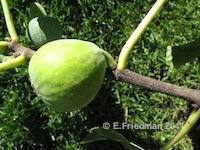
Fig trees don't grow in all parts of the world, and they take up a lot of space (Our two are eating our smallish garden). They are not a common garden plant. And because fresh figs do not store or travel well, it's a bit unusual to get them.
Fig lovers go wild for fresh figs. My husband is the fresh fig lover in our home, so I am always on the alert to tell when figs are ripe. Otherwise, the birds take all.
Let's here what you think about figs.
Have you eaten fresh, ripe, raw figs?
A New Approach to Cooking
This book combines recipes with many foods including figs with a refreshing point of view about cooking simple foods that are delicious. The author is chef at Chez Panisse restaurant in Berkeley. Reviewers loved this book and how ti makes you look at cooking.
Another Delicious Fruit: Blueberries
While you a waiting for your figs to get ripe, you might want to sample another delicious fruit that is particularly good for your health: blueberries. They are rich in anti-oxidants. You can get blueberries fresh in most grocery stores even if you do not live in blueberry country. Just rinse and eat - great! Or add to cereal, pancakes, muffins. A blob of yogurt goes well with blueberries, too.
For the most unusual way to eat them, try blueberries with tomato soup. See the featured lens on Blueberries and Red Soup from TJ's.
And consider trying dried blueberries - they offer a surprising burst of flavor for a great snack or addition to a salad or cereal. Amazon has dried blueberries and books with blueberry recipes.








![Very Blueberry: [A Cookbook]](https://m.media-amazon.com/images/I/51d33rnoOML._SL160_.jpg)



